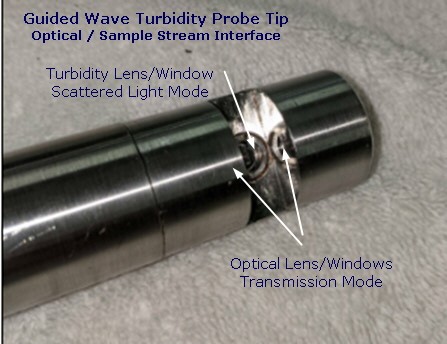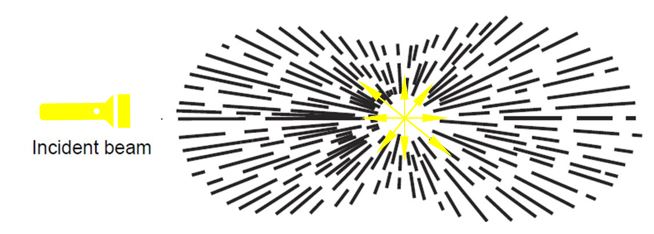Visual NDT
Relating Particle Size and Turbidity With a ClearView db
Published on 21st July 2021

Turbidity is a scale used to define the cloudiness or opaqueness of a liquid sample. The liquid in a reactor or pipe can contain suspended solid matter consisting of particles of many different sizes. These small (1-200 micron) particles cause the liquid to appear turbid by scattering light. The amount of light scattered by particles suspended in a liquid depends on the concentration and geometry of the particles, and on the optical properties of the suspension. The Turbidity SST probe simultaneously collects the forward (180 degree) scattering and the sideways (90 degree) scattering of light. By sending the light through fiber optic cables to Guided Wave’s ClearView db Photometer the light can be analyzed and the particle concentration and characteristic particle size information can be determined. Additional lab work may be required to correlate scattering data, NTU values, and particle size information for a specific sample composition. The Turbidity insertion probe and the Turbidity flow cell were developed to specifically measure the turbidity of a solution in a batch reactor or pipeline.

The NTU and FNU scales
Both the NTU (Nephelometric Turbidity Unit) and FNU (Formazin Nephelometric Unit) scales measure the ratio of light scattered 90 degrees relative to the incident light beam. The NTU scale is defined by EPA Method 180.1 as using White or broadband light source with peak spectral output of 400-680 nm. Whereas, the FTU scale as defined by ISO 7027, employs a monochromatic light source with typical output in 780-900 nm range. Due to the use of different light sources and the variation of optical properties between types of samples, there is not a straight forward conversion between NTU and FTU. They represent two different methods for measuring the scatter phenomenon of a liquid sample.
The ClearView db Photometer uses a Tungsten light source and can measure transmission between 450 nm – 2100 nm. Therefore, the ClearView db can be calibrated in the factory to measure NTU with either an insertion probe or a flow cell. The NTU calibration is often limited to only the intensity of 90 degree or sideways scattered light and a series of reference samples.
Particle size information can be directly estimated because the ClearView db is capable of measuring the forward scattering at visible and near infrared wavelengths, and sideways scatter from the wide bandpass turbidity filter. The measurement of forward scattering at higher wavelengths allows for larger (>200 micron diameter) particles to be measured. The dual measurement allows for a customizable turbidity measurement
Types of Light Scattering
There are two types of light scattering that are of interest when measuring turbidity. To reduce measurement noise, The Turbidity SST Probe and Turbidity Flow Cell were developed to measure the sideways (90 degree) and forward (180 degree) scattered light.

The first is Rayleigh scattering, which is important when the diameter of the particles are much smaller than the wavelength of light used. During Rayleigh scattering the light is scattered in all directions.

The second is Mie scattering which occurs when the particle size is at least 1/10th of the wavelength of light. During Mie scattering the light is preferentially scattered in the forward direction.
How to relate NTU, Forward Scatter, Sideways Scatter and Particle Size
The journal article, Particle Concentration, Size and Turbidity by Kleizen et. al, demonstrates for a given sample composition (solvent and solute combination), the particle size can be inferred by measuring the ratio of forward to sideways scattered light.
“The particle concentration and the characteristic particle size of a suspension of particles strongly influence the scattering of light. For primary scattering the amount of scattered light will be linear with the particle concentration; however, for multiple scattering the amount of scattered light will be a higher-order function of the concentration.
The amount of light scattered also depends on the angle at which the light scattering is measured. If multiple scattering is more important for one angle than for another, it is possible to obtain both the particle concentration and a characteristic particle size by measuring the amount of light scattered at the two angles. As multiple scattering depends on the length of the optical path, the accuracy of the method can be increased by changing this length for one angle.”
- https://doi.org/10.1016/S0015-1882(97)84175-4
Correlation between NTU and Particle Size is Sample Dependent
Kleizen also demonstrates that due to the difference in optical properties such as the index of refraction of the solvent and the shape of the suspended particles, the relationship between sideways scatter, forward scatter, and particle distribution will vary. Therefore the ClearView db which is factory calibrated for NTU and forward scatter intensity, will need to undergo additional onsite testing to determine how these measurements best correlate with the particle size present in a specific reactor or pipeline.
Example of using a ClearView db to Target the Formation of Crystals with an Average Diameter of 75 nm
In the case of monitoring nucleation, a ClearView db could be configured to measure the intensity at 550 nm and 750 nm on the forward scatter fiber of a Turbidity SST Probe. Because the initial crystal seeds are much smaller than the 550 nm or 750 nm light being measured Rayleigh scattering will occur. As the tiny crystals begin to coalesce into larger crystals the scattering will start to change. Once the particles reach a diameter of roughly 55nm, Mie scatter will start to occur. The ClearView db will measure this by seeing an increase in the forward scatter reading for 550 nm. And subsequently a decrease in the sideways scattering reading on the large bandpass turbidity filter. The 750 nm channel will continue to measure the Rayleigh scattering occurring at the higher wavelength. Once the crystals have grown to an average diameter of 75 nm, the ClearView db will begin to see an increase in Mie (forward) scattering on the 750 nm detector. By setting process limits based on the intensity of forward and sideways scattered light at 550 nm and 750 nm, the Clearview db can signal when the target crystal size has been reached and the reaction should be halted.
With thoughtful selection of up to 6 filters the ClearView db can be customized in the factory to monitor different particle sizes and additional process parameters such as acid number or APHA color. For more information on the versatility of the Clearview db Photometer contact Guided Wave.
Applications for turbidity measurement:
- Polymerization and Nucleation rate
- Crystallization growth rate
- Verifying API dissolution
- Filtration and solids breakthrough
- Separation and precipitation of particles from suspension
- Water contamination in Fuel (gasoline) causes droplets that increase the turbidity
- Water quality due to suspended solids
The Turbidity Probe
The Turbidity SST Probe is designed to withstand corrosive processes. The body of the probe is built from 316L stainless steel. The probe’s sapphire optical windows are sealed to the probe body with polymer o-rings chosen to be compatible with your process. On request, the Turbidity Probe can be supplied welded to an ANSI or DIN process flange. One of the primary advantages of UV-Vis and NIR process spectroscopy is the utilization of intrinsically safe fiber optic cables to remotely locate the analyzer relative to your process. Inline Turbidity probes eliminate costly and problematic fast loops and sample systems typically associated with flow cells and other sample interfaces.
Source: https://guided-wave.com/relating-particle-size-turbidity/








